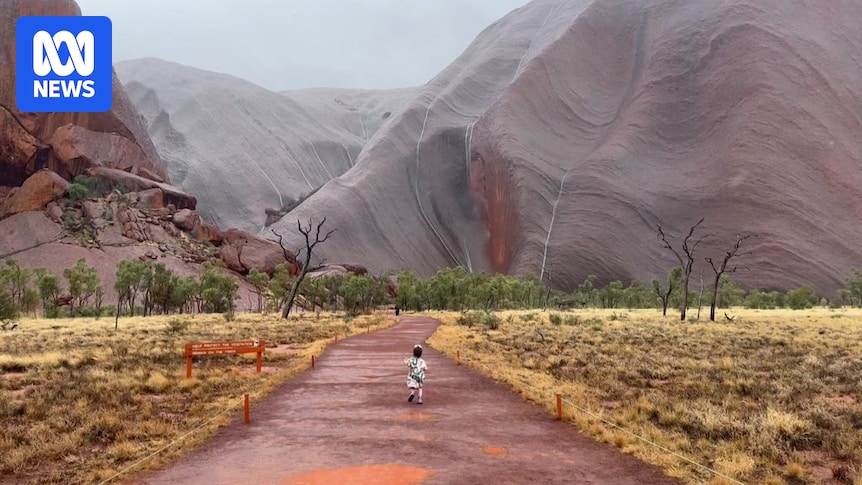Wet weather closures at one of Australia’s top tourist destinations are costing operators tens of thousands of dollars each season.
Nick Bitar owns Outback Cycling, which rents bikes at the base of Uluru to enable tourists to cycle the 10-kilometre loop of the rock.
But when it rains, Parks Australia rangers can close the dirt path to bikes and segways.
“We work under quite strict conditions with Parks Australia and if there’s any water on the track they’ll tell us that we’re not allowed to operate and have to cancel our bookings,” Mr Bitar said.
“You are still free to walk around the rock; it’s still open.”
The path around the base of Uluru becomes unusable to several tour operators in wet weather. (Supplied: Outback Cycling)
In a recent wet weather event, Mr Bitar said the business was forced to cancel more than 200 bookings in one week.
“We can’t rent our bikes until the track is properly dry,” he said.
Mr Bitar said it also left hundreds of unhappy customers.
“People will cancel one day then we’ll put them on to the next day, and then the next day we might have to cancel,” he said.
“By then they’re leaving town and we have to refund them and they haven’t had a chance to re-book another attraction because they’ve been waiting for the rain to abate.”
Mr Bitar said he had a great working relationship with Parks Australia but would like to see the authority prioritise maintenance on the trail so that all customers were getting a great experience.
“Uluru is Australia’s crown jewel tourist attraction and it’s disappointing when facilities are not kept to that standard,” he said.
“We pay Parks Australia a fee to use the trail and they should be kept to a high and safe standard.”
10 per cent closure rate
Mark Swindells operates Uluru Segway Tours, and agreed the track closures were an issue for his business.
“We lost 36 days of trading because the walk or the track around the base was closed, so we couldn’t get our segways on,” he said.
“That’s 10 per cent of the year.”
Uluru Segway Tours cannot operate when there is water on the track. (Supplied: Uluru Segway Tours)
Mr Swindells said wet weather closures were more common than people realised.
“2017 was a very wet year, and for one month alone, the northern face of the track was closed around Uluru to walkers as well,” he said.
“It wasn’t just to bike riders and segways.”
Mr Swindells said there was some good news on the horizon, but expected a solution was “still years away”.
“[Parks Australia] are working on it at the moment,” he said.
“They’ve got people doing consultation work and there is funding to go ahead and improve probably about half the track.”
Protecting an iconic experience
Tourism Central Australia chief executive Danial Rochford said closures were costing small business, and detracted from the tourist experience.
“Rain on the rock is such an iconic part of the experience,” he said.
Mr Rochford wants Uluru funding to be an issue in the next federal election. (Supplied: Danial Rochford)
“Those statistics are showing that [rain closures] are a bit beyond just a one-off.”
Mr Rochford said it was an infrastructure issue that was costing the regional economy.
“It’s important that Parks Australia understand that the development of infrastructure around Uluru is critical for tourism,” he said.
“We certainly will foresee that this will be a hot ticket item for us leading into the federal election to ensure that infrastructure is rolled out at Uluru.”
Upgrades on the horizon
A Parks Australia spokesperson said planning and consultation was underway to upgrade parts of the Uluru Base Walk, including considerations for track safety and functionality in key user areas.
But they did not provide details on timeframes, or whether this would allow for all-weather access.
Uluru shrouded in cloud cover after rainfall in the region. (Supplied: Rachel Frearson )
“The weather at Uluru-Kata Tjuta National Park is highly variable and can range from extreme heat to near zero temperatures throughout the year,” the spokesperson said.
“The average annual rainfall is around 300 millimetres however this varies from year to year.
“Seeing rain on Uluru is generally quite rare for visitors however in recent years, La Niña conditions have seen more frequent major rainfall events.”
